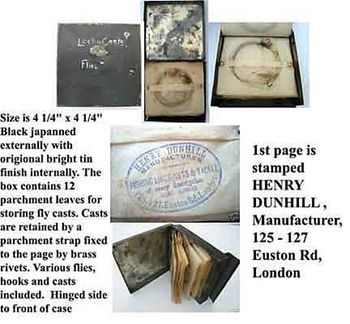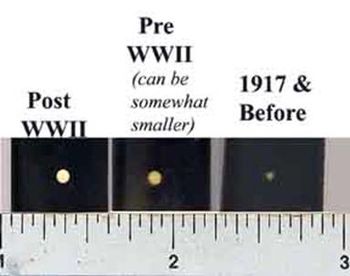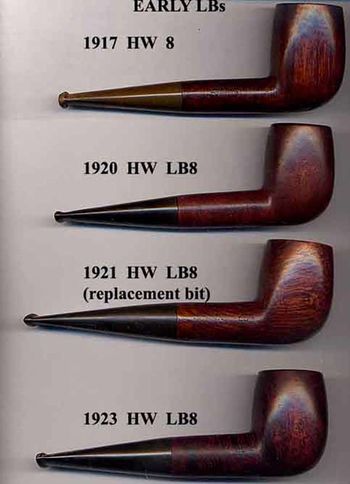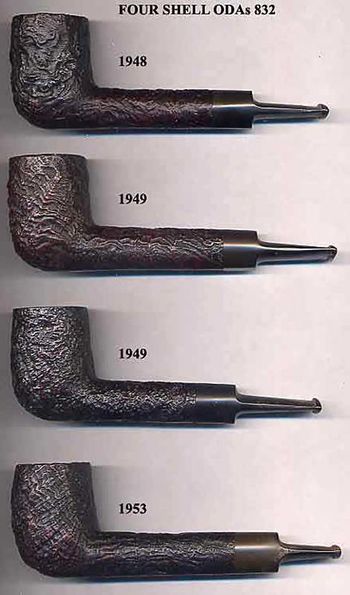The Earliest Dunhill?/fr: Difference between revisions
(Created page with "Depuis 1918 Dunhill marquait ses pipes de finition lisse avec un code date (non numérique jusqu'en 1921 puis numérique en 1922 et après) qui nous permet de déterminer l'an...") |
(Created page with "Ce que Kevin a mis en évidence, c'est que si le dessous de la plupart des premiers tuyaux Dunhill n'est pas marqué ou porte la mention "REG. No [sur] 654638", certains sont...") |
||
| Line 16: | Line 16: | ||
Depuis 1918 Dunhill marquait ses pipes de finition lisse avec un code date (non numérique jusqu'en 1921 puis numérique en 1922 et après) qui nous permet de déterminer l'année de production. Mais pour les premières années de production, de 1910 à 1917, lorsque Dunhill ne se préoccupait pas de déterminer la date de production d'une pipe, et hormis ce que l'on peut déduire des différents marquages de brevet, toute datation précise était impossible. Toutefois, récemment, un collègue collectionneur, Kevin Chapman, s'est penché sur les tuyaux de ces premières pipes et ce qu'il a trouvé nous permet maintenant de dater ces premières pipes avec un peu plus de précision. | Depuis 1918 Dunhill marquait ses pipes de finition lisse avec un code date (non numérique jusqu'en 1921 puis numérique en 1922 et après) qui nous permet de déterminer l'année de production. Mais pour les premières années de production, de 1910 à 1917, lorsque Dunhill ne se préoccupait pas de déterminer la date de production d'une pipe, et hormis ce que l'on peut déduire des différents marquages de brevet, toute datation précise était impossible. Toutefois, récemment, un collègue collectionneur, Kevin Chapman, s'est penché sur les tuyaux de ces premières pipes et ce qu'il a trouvé nous permet maintenant de dater ces premières pipes avec un peu plus de précision. | ||
Ce que Kevin a mis en évidence, c'est que si le dessous de la plupart des premiers tuyaux Dunhill n'est pas marqué ou porte la mention "REG. No [sur] 654638", certains sont marqués "PROV. PRO [sur] 2983/16". Le "/16" ramène à 1916 la demande de Dunhill concernant ce qui deviendrait le numéro de registre des tuyaux Dunhill et nous pouvons en déduire que celui-ci a été accordé vers 1917. (Les tuyaux Dunhill ont été marqués d'un numéro d'enregistrement jusqu'en 1933 environ). | |||
Further, armed with this new information together with pipes in hand, we can now date the end of the use of the original small White Dot on bits also to circa 1917. | Further, armed with this new information together with pipes in hand, we can now date the end of the use of the original small White Dot on bits also to circa 1917. | ||
Revision as of 18:28, 12 October 2022
Ecrit par J John C. Loring
Mis à disposition par Yang Forcióri et traduit par Jean-Christophe Bienfai
L'histoire commerciale de Dunhill remonte au début du XIXe siècle à Londres, où l'arrière-grand-père d'Alfred était marchand de tissus et de mercerie, la famille vivant au-dessus de la boutique. La génération suivante vit le grand-père d'Alfred se faire un nom en tant que marchand de charbon et fabricant de sacs, sa famille vivant toujours au-dessus de la boutique. Mais au cours de la seconde moitié du XIXe siècle, Henry, le père d'Alfred, put installer sa famille dans une maison indépendante et, en 1885, il avait étendu son activité de fabrication de sacs aux toiles, bâches stores à ressort, cordes, tapis, harnais, vêtements d'équitation de toutes sortes au 125-127 Euston Road. Alfred, âgé de 15 ans, rejoint son père en tant qu'apprenti en 1887. Si l'on compare le fils au père, il est clair qu'Alfred partageait la volonté d'Henry de développer l'entreprise familiale, mais ce fut Alfred qui chercha à équiper les classes supérieures plutôt que populaires, en ouvrant DUNHILL MOTORITIES pour répondre aux besoins des riches amateurs d'automobiles en 1893.
On ne sait jamais ce que l'on va trouver sur eBay, mais comme je n'avais jamais entendu parler d'un produit Dunhill datant d'avant la création de l'entreprise par Alfred, j'ai été surpris lorsque ma recherche hebdomadaire a abouti à un étui à mouches pour la pêche à la truite en métal cabossé portant la marque de HENRY DUNHILL à l'adresse 125-127 Euston Road. Cette pièce sans prétention date très probablement de la fin des années 1880 et reflète peut-être les efforts de l'apprenti Alfred pour orienter l'entreprise familiale vers les classes supérieures. Quoi qu'il en soit, il s'agit certainement de l'un des plus anciens produits Dunhill encore existants.
Sa taille est de 4 ¼ x 4 ¼ (10,8 x10,8 cm). L'extérieur est laqué noir avec une finition d'origine en étain brillant à l'intérieur. La boîte contient 12 feuilles de parchemin pour stocker les mouches sur soie lestée. Les soies lestées sont retenues par une bande de parchemin fixée à la feuille par des rivets en laiton. Diverses mouches, hameçons et plombs sont inclus dans la boîte. Charnières sur le devant de la boîte.
Précisions sur les premières datation
Depuis 1918 Dunhill marquait ses pipes de finition lisse avec un code date (non numérique jusqu'en 1921 puis numérique en 1922 et après) qui nous permet de déterminer l'année de production. Mais pour les premières années de production, de 1910 à 1917, lorsque Dunhill ne se préoccupait pas de déterminer la date de production d'une pipe, et hormis ce que l'on peut déduire des différents marquages de brevet, toute datation précise était impossible. Toutefois, récemment, un collègue collectionneur, Kevin Chapman, s'est penché sur les tuyaux de ces premières pipes et ce qu'il a trouvé nous permet maintenant de dater ces premières pipes avec un peu plus de précision.
Ce que Kevin a mis en évidence, c'est que si le dessous de la plupart des premiers tuyaux Dunhill n'est pas marqué ou porte la mention "REG. No [sur] 654638", certains sont marqués "PROV. PRO [sur] 2983/16". Le "/16" ramène à 1916 la demande de Dunhill concernant ce qui deviendrait le numéro de registre des tuyaux Dunhill et nous pouvons en déduire que celui-ci a été accordé vers 1917. (Les tuyaux Dunhill ont été marqués d'un numéro d'enregistrement jusqu'en 1933 environ).
Further, armed with this new information together with pipes in hand, we can now date the end of the use of the original small White Dot on bits also to circa 1917.
Putting this all together with what we had already known, we can now date Dunhill pipes by year back to at least 1916, as set forth in the following chart for pipes stamped DUNHILL [over] DUKE ST S.W.]:
__________
- No "INNER TUBE" or patent stamp & no bit stamp [no such pipe has yet been seen] -- 1910 - 1912
- 1912 patent stamp, small white dot & no underside bit stamp* -- 1912 - 1916
- 1914 patent stamp, small white dot & no underside bit stamp* -- 1914 - 1916
- 1915 patent stamp, small white dot & no underside bit stamp* – 1915 – 1916
[PROVISIONAL PROTECTION BIT STAMP INTRODUCED SOMETIME IN 1916 & REPLACED BY REGISTRATIONNUMBER BIT STAMP SOMETIME IN 1917]
- any patent stamp, small white dot & PROV.PRO underside bit stamp -- 1916 - 1917
- any patent stamp, small white dot & REG.No underside bit stamp -- 1917
[MEDIUM WHITE DOT REPLACES SMALL WHITE DOT SOMETIME IN 1917]
- any patent stamp, medium white dot & PROV.PRO underside bit stamp -- 1917
- patent stamp, medium white dot & REG.No underside bit stamp -- 1917 - 1918 (through October) (also for standard "A" ‘Duke ST’ pipes, an "Ao" stamp indicates June - October 1918)
__________
*When using this chart it is important to remember that underside bit stamps are easily buffed off and bits may be replaced.
It would also appear that two other early nomenclature variations have no dating significance. First, on some pipes the INNER TUBE stamp is found without surrounding quotes and on others with such quotes - “INNER TUBE”. It would appear however, that this is simply a question of the patent stamp used, specifically “INNER TUBE” for pipes stamped with the 1912 patent and INNER TUBE for pipes stamped with the 1914 or 1915 patent. Second, it would appear that the alignment of DUNHILL [over] ] DUKE ST S.W. is random.
The Oldest LB?
In the Winter-Spring 2005 Ephemeris I wrote about the Dunhill LB (“Dunhill Large Billiard Variations” at pp. 37-39) and specifically about the 1920’s Shell ‘thin shank/straight bowl walls’ variation to the standard ‘thick shank / applish bowl’ LB. A subsequent acquisition however, leads me to view matters a bit differently.
It is a 2” tall, 5 ¾” long 1917 Dunhill Bruyere billiard stamped H.W DUNHILL [over] DUKE ST S.W. on one side and “INNER TUBE” [over] PAT. No 5681/12 8 on the other. This is a remarkably large pipe for the “Duke Street” period, in terms of bowl height and length it is an LB and like smooth finished LBs of the 1920s it is stamped “H.W” (‘handworked’) and with an “8” inner tube size. It is not stamped “LB” but then that shape designation was probably not introduced until 1918/1919, so it is probably best viewed as a prototype.
But most interesting in that regard is that this 1917 ‘prototype’ has straight sided bowl walls and medium rather then thick shank, that is to say it is more properly a prototype of the 1920s Shell LB variation rather then of the ‘standard’ applish bowl / thick shank LB. All of which leads me to suggest that perhaps the thin shank/straight bowl wall LB must be viewed as the original shape and that the applish bowl/thick shank LB must be viewed as the variation which quickly became the norm first for smooth finishes and by the 1930’s for all finishes.
The Oldest Modern ODA?
The ODA 832 is essentially an LB with an extended shank and a stub saddle bit. It was one of the first, or as it now appears, the first modern, post WWII, standard shape ODA. In that early post war period, in distinct contrast to before the war, briar was ‘dear’ and in those circumstances the 832 had a particular virtue. If a costly briar block allowed for an extended shank it could be finished as an 832 to be sold at the premium ODA price, but if an extended shank was not possible then the pipe could still be finished as an LB.
Until the new century it was uniformly believed that the first modern standard shape ODAs were introduced in 1950 when the ‘800’ shape number series was inaugurated. Then around 2001 a couple 832 shapes from 1949 were found stamped only ODA (since the ‘800’ shape number series had not yet been established) so the year of introduction was moved back a year.
Visually, at least to my eyes, the 832 appears to be an ungainly pipe but in actual use, at least for me, it is a most comfortable smoke, easily held in the mouth - my ‘if you were stranded on a desert island and allowed to take but one pipe’ pipe. It is also a very rare shape, so when a Shell 832 appearing to date to the mid 1950s came up on eBay with a serious bowl crack I went after it, figuring that I could repair the crack (an easy and unobtrusive repair for Shells) and have a ‘smoker’ that I could enjoy without fear of a major economic loss if I inadvertently dropped it. Imagine then my surprise when upon receiving my eBay ‘smoker’ I discovered that in fact it dates to 1948, making it unquestionably the earliest known modern standard shape ODA.
Back to Loring's articles here



